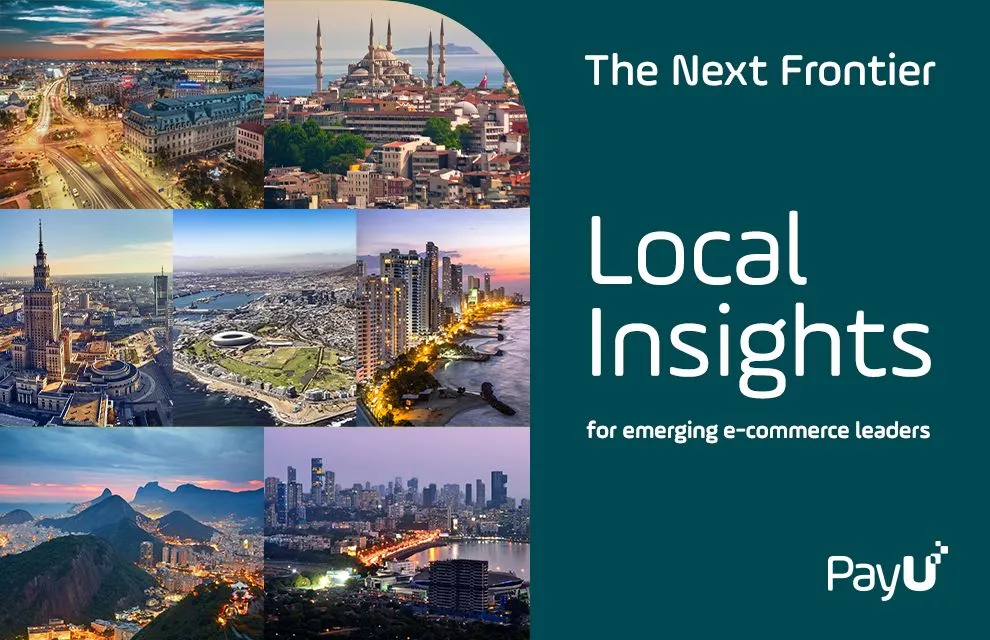More PayU insights
Learn more about e-commerce, fintech, and financial inclusion in emerging markets.
Visit resource hubPayU Country Manager Joanna Pienkowska-Olczak looks at some of the key drivers behind e-commerce in Poland. 23/06/2021

Already one of Europe’s leading growth markets, Poland’s e-commerce sector advanced significantly amidst the upheaval of 2020.
27% of internet users in Poland declare that they have started shopping online more often due to COVID-19 pandemic. At the same time, interest in online sales and online payments increased among enterprises by 50%. And in a difficult year for retail businesses as a whole, 70% of small and medium-sized enterprises selling wholly or partially online declared that the pandemic had increased their turnover.
How does the landscape look for e-commerce and online payments in Poland after the events of the past year? And what are the challenges and opportunities going forward? As part of The Next Frontier, PayU’s recent report on e-commerce opportunities in emerging markets, we reached out to Joanna Pienkowska-Olczak, Country Manager for PayU Poland, to share her thoughts on the present and future of Polish e-commerce.
Scroll below to read Joanna’s responses and be sure to check out our other recent conversations with leaders in some of the world’s top emerging e-commerce markets.

For many small and medium-sized enterprises in Poland, the development or launch of the online sales channel has become the only chance to continue operations as a result of multiple lockdowns since March 2020. The number of newly opened online stores on the PayU platform soared in April and May 2020, during the so-called first coronavirus wave. These dynamics slowed down later in the year as in-person retail re-opened, but from September we started to notice significant increases in the registration of new stores in our system once again.
On the other end of the spectrum we also saw a lot of larger companies – many of whom had already been selling online – focus on the further digitization of their business by improving sales, logistics and payment processes. The implementation of omnichannel strategies has become one of the most important and urgent tasks for the largest retailers, whose brands we are used to meeting in shopping malls. This was a key reason why we saw big companies in common e-commerce verticals like fashion, beauty, and electronics continue to stay on top of their markets.
Another factor that has been influencing the growth of e-commerce for a long time is the growing digital competence of consumers, resulting from growing smartphone penetration. Shopping is one of the activities that we perform most often on mobile, next to the standard search for information or browsing social media. Of the 20.3 million internet users in Poland that shop online, 59% do so from their mobile phones.
There is also an upward trend in the use of many different devices for shopping purposes – apart from laptops and smartphones, there are also smartwatches and smart TVs. As in many other places, the comfort of Polish consumers with all of these channels is only increasing, which in turn makes people even more eager to buy online.
New payment and consumer protection regulations, both at the European Union level and locally in Poland, have also had a positive impact on consumer trust in e-commerce and breaking a certain barrier of distrust that we deal with in the case of people who are just starting to shop online. The pandemic brought many of these customers online for the first time. The number of people buying from a laptop or smartphone for example has been on a steady rise, but never at such a rapid pace. In 2020, 73% of internet users in Poland reported shopping online, an increase by 11% compared with the previous year. Growth between 2018 and 2019, by comparison, was only half this amount (6%).

Trust and user experience will be a big factor in sustaining the growth in Polish consumers willing to shop online. The “new consumer” mentioned earlier is a person who has just started their adventure with online shopping and thus also with online payments. It is therefore quite natural that at the beginning of this path, he or she may have find it difficult to be convinced of the next stages of the purchasing process, especially until the payments are made. Therefore, building a simple and, at the same time, safe environment in which the transaction can be finalized is crucial for gaining the trust of this group of customers.
The pandemic only confirmed our earlier belief that UX plays a key role in encouraging “new consumers” to buy and pay online. This means, among others, optimizing the process of searching products and check-out but also optimizing and simplifying payment processes to the maximum – including introducing one-click solutions, adjusting payments to mobile devices and providing a wide range of payment methods – so that the customer can choose the option with which they feel the most comfortable.
With more and more new payment methods available, it is also necessary to ensure the appropriate method of their authentication. The payment industry throughout the European Union must therefore face the challenge of improving the consumer experience in such a way that is fully compliant with new regulations, which are aimed at increasing consumer safety and increasing the number of approved transactions. This includes for example implementation of a new transaction authorization standard based on the 3DS 2.0 protocol, using a wider range of data, as well as biometric authentication.
Another challenge is to ensure appropriate payments for various types of business models operating in e-commerce: both for ready-made store solutions (including plugins for the most important open source platforms), marketplaces, and customized online stores. PayU supports every business model by providing a wide range of payment solutions via our platform, and we also support merchants in building a safe and efficient purchasing process that translates into customer trust and loyalty.
It starts with omni-channel. The pandemic is accelerating the shift towards omnichannel selling, which has been happening already for a long time. Eventually we will no longer distinguish between e-commerce, m-commerce, social commerce or sales in brick-and-mortar – there will be just ‘commerce’.
The boundaries are already blurring. Consumers start the purchasing process on one device and end up on another. Therefore, the issue of a unified shopping experience regardless of the sales channel or device becomes extremely important, which also means ensuring uniform payment methods. For example, for a large group of people who already use Google Pay or Apple Pay while shopping offline it should also be possible to pay in this way on the internet. We do not need a card, we don’t make transfers, but we use the tool we use to pay in a stationary store. It is therefore important that online stores offer the full range of payment methods to increase customer satisfaction.
I am convinced that thanks to the appropriate integration of sales channels, brick-and-mortar stores (when they are reopened) can have a significant share in generating additional sales across channels through different forms of upselling. Let’s imagine, for example, a simple situation in which a customer comes to a store to pick up a package ordered from that merchant on the internet, and receives a special discount for shopping in the store only on that day. Other opportunities to generate future e-commerce growth can also be seen in new technologies that make our entire environment increasingly automated. Technologies such as virtual reality, artificial intelligence or biometrics, used to authenticate and authorize transactions, will also have an increasingly strong impact on the growth of online purchases, as well as online payments made at the time of ordering, thus reducing the amount of cash in circulation. New technologies will also continue to contribute to the development of new payment methods, including online credit and deferred payments, where in-depth data analysis combined with machine learning will play an important role in terms of payment terms.
We are also optimistic about the fact that more and more Polish merchants are looking at cross-border opportunities. Companies that are just starting to sell online often offer several language versions of the e-store right away. With PayU’s platform merchants can also adapt the payment methods to the preferences of consumers in a given country, so that the customer can always find their preferred method of paying.
One of our strengths at PayU is our ability to offer a single platform connecting merchants to local payment methods all over the world. We can help any merchant anywhere to develop cross-border sales not only in Europe, but also throughout South America, Asia, and Africa. This is a very important trend that cannot be underestimated, as consumers’ openness to purchases from international stores and websites keeps growing. As just one example: currently, 35% of Europeans who shop online buy from shops outside their own country.

Get further insights on the e-commerce landscape across Poland and nearly 20 other emerging e-commerce markets where PayU operates around the world.
Combining external sources with local data directly from PayU’s payments platform, our report also provides a window into the payment ecosystem across the countries surveyed, leveraging our experience as a leading payment technology platform offering merchants a single global solution for emerging as well as established markets.
Fill in the form to download our report and learn more about the fast-moving digital landscape in some of the world’s most exciting growth markets for e-commerce.